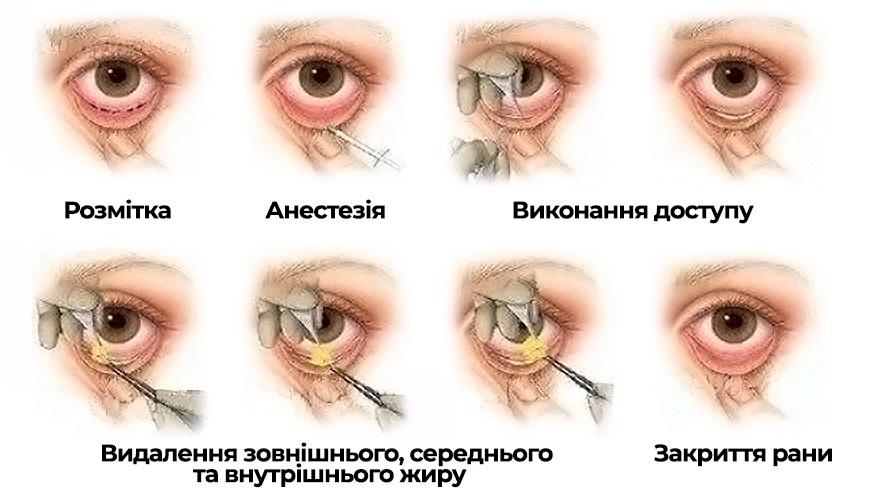How to remove “bags under the eyes”: surgical and non-surgical methods
Everyone knows what “bags,” puffiness, and dark circles under the eyes are. In addition to lifestyle, skin care, and nutrition, genetic factors and skin elasticity play a major role in the appearance of bags under the eyes. To get rid of this problem, women and men can resort to non-surgical methods, but it is plastic surgery that can bring high-quality and lasting results.
There are several factors that contribute to the appearance of dark circles and bags under the eyes. To better understand how to get rid of this problem, let's first figure out what causes bags under the eyes.
Causes of bags under the eyes
- Genetics. One of the factors that can cause puffiness under the eyes is genetics. Some people have a genetic predisposition to developing bags under their eyes caused by fat accumulation in the lower eyelids. As a result, the eyes may appear puffy and tired.
- Aging. This irreversible process can also cause the skin on the lower eyelids to lose elasticity and the muscles to weaken and thin, which leads to the appearance of wrinkles and bags under the eyes. Dark circles under the eyes may also appear with age, as blood vessels become more visible under thin skin.
- Fluid retention in the body due to certain medications, as well as kidney disease, thyroid disease, myasthenia gravis, and eye infections can also cause puffiness under the eyes.
Non-surgical methods for removing bags under the eyes
So, how can you get rid of bags under your eyes without surgery? There are now many treatments available for puffiness in this area to give you a fresher appearance.
- Under-eye fillers. Hyaluronic acid injections can remove small amounts of swelling from the subcutaneous fatty tissue. They are performed in a dermatologist's office, and the results last from 6 to 12 months, depending on individual characteristics and the severity of the problem.
- Botox under the eyes. Botox injections relieve muscle tension around the eyes and improve the patient's appearance. This can partially solve the problem of puffiness, but not eliminate it completely. This is a temporary solution to problems with the skin under the eyes, as Botox injections must be repeated every 3-6 months to maintain a favorable result.
- Laser resurfacing is another good option for non-surgical removal of bags under the eyes. During this procedure, a dermatologist uses a laser to remove a layer of skin. During the recovery process, active collagen production is stimulated to form more elastic skin. However, this method does not completely eliminate bags under the eyes.
- Chemical peeling. During this procedure, a dermatologist can improve the appearance of the skin by applying a special chemical solution. This makes the skin more elastic and radiant after renewal.
- PRP (platelet-rich plasma) injections are ideal for the lower eyelid area and strengthen the skin, giving the patient a more rested and youthful appearance.
- Home remedies, including cold compresses and patches, applying special creams, moisturizing the skin, etc. These procedures help to remove slight swelling in the morning after eating too much salty food or alcohol and are a relaxing addition to your daily beauty routine.
Removing bags under the eyes with plastic surgery
With age, the skin in the lower eyelid area becomes thinner, and the connective and soft tissues under the eyes sag, forming unattractive bags. Excess fluid can also accumulate in these areas. To remove subcutaneous fat tissue under the eyes, experienced plastic surgeon Dmytro Slosser uses the most modern methods of plastic surgery.

Lower blepharoplasty effectively and permanently resolves the problem of bags under the eyes by removing excess fat and skin. If necessary, the plastic surgeon can lift the sagging lower eyelids, which are not only an aesthetic problem but also a cause of certain eye diseases.
There are several different approaches to lower blepharoplasty. The plastic surgeon may make an incision directly along the lower lash line or along the pink mucous membrane, also known as the lower eyelid conjunctiva. During the operation, excess fatty tissue is removed and sagging skin is tightened.
The recovery process after lower blepharoplasty is usually straightforward: patients can return to office work and driving within a week after surgery. Light exercise and other physical activities can be resumed in 2-4 weeks.
Contact me
Plastic surgeon
Ukraine, Kyiv, Shchekavytska St., 9a
(Clinic "Nove Tilo")


